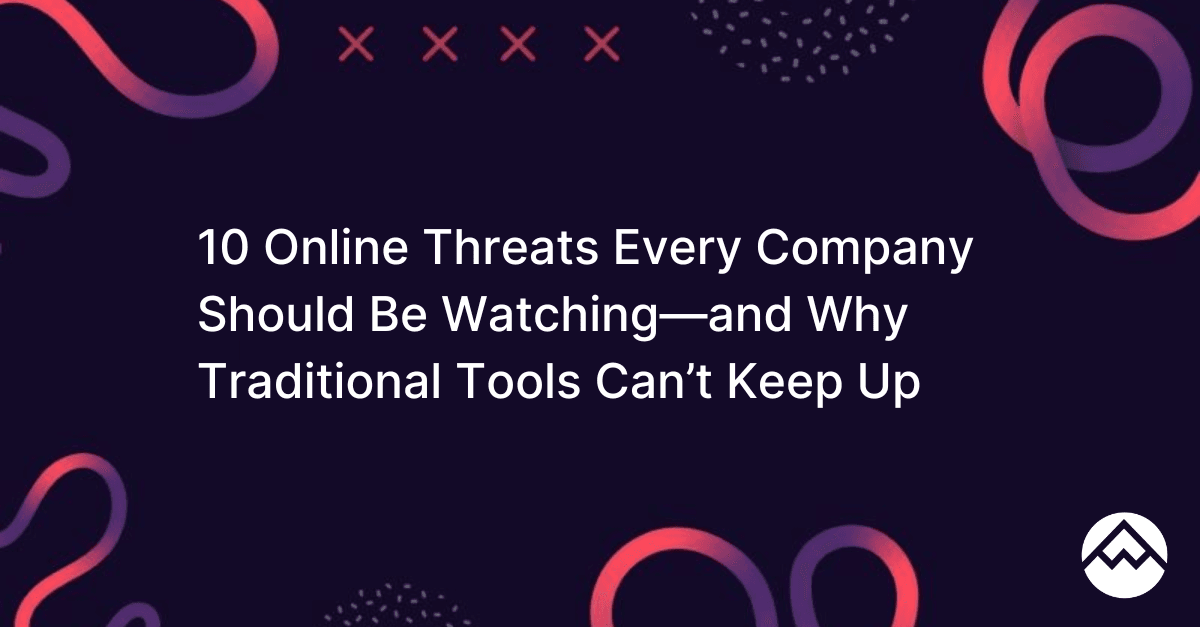
10 Online Threats Every Company Should Be Watching—and Why Traditional Tools Can’t Keep Up
It only takes one post. One tweet, TikTok, or out-of-context video clip can ignite a firestorm, damaging your reputation, sinking stock value, or sparking a boycott before your team even knows what hit them.
In today’s hyper-connected world, the biggest risk to your brand isn’t always a data breach or cyberattack. It’s what people are saying, and how fast those narratives can spread, mutate, and take hold.
From false narratives to coordinated bot campaigns, online threats are evolving. And most companies are still using tools built for a slower, simpler internet.
To stay ahead, organizations need a new approach to reputation and risk, one built around narrative intelligence.
What is a Narrative Threat?
A narrative threat is a harmful storyline spreading online that can shape public perception and lead to real-world consequences. It may be entirely false, exaggerated, taken out of context, or intentionally manipulated—yet once it gains traction, it can damage brand reputation, influence customer behavior, and spark crises faster than any press release can respond.
Unlike traditional cybersecurity threats, narrative threats aren’t hidden in your systems—they’re happening in plain sight, across social media, news, forums, and fringe platforms.
What is Narrative Intelligence?
Narrative intelligence is the ability to detect, decipher, and defend against the online stories that shape public perception, influence reputation, and drive real-world impact. Unlike traditional brand monitoring or sentiment analysis, narrative intelligence helps companies understand why conversations are happening, where they’re gaining traction, who is pushing them—and what to do about it.
Below are 10 online threats every organization should be tracking right now—and why traditional tools can’t keep up.
1. False or Misleading Narratives
False narratives can erode brand trust before your team has time to react. Often framed emotionally and shared out of context, they’re hard to debunk once they take off.
Why it’s growing: AI tools now help generate compelling false narratives at scale, and social platforms reward viral outrage.
2. Deepfakes and Synthetic Media
A fake video of your executive or spokesperson making a controversial comment can now be created and spread within hours.
Why it’s growing: Generative AI has made it cheap and easy to create believable video, audio, and images—targeting your brand’s credibility.
3. Bot Amplification and Coordinated Influence Campaigns
Bots and troll networks can rapidly inflate engagement around a narrative, making it appear more widespread or legitimate than it really is.
Why it’s growing: Bad actors use bots to manipulate platform algorithms and manufacture consensus—especially during crises or news cycles.
4. Out-of-Context Screenshots and Video Clips
Framing is everything. Even a truthful statement can go viral for the wrong reasons when cropped, clipped, or recontextualized.
Why it’s growing: Attention spans are short and visuals move fast—what goes viral isn’t what’s true, it’s what hits first.
5. Online Boycotts and Hashtag Campaigns
From #BoycottTarget to industry-specific movements, online communities can mobilize against brands quickly, especially when driven by ideology or controversy.
Why it’s growing: Boycotts are often seeded in fringe platforms, coordinated in private groups, then explode publicly across mainstream social media and news in hours.
6. Disgruntled Employees Going Public
Layoffs, ethics complaints, or internal dissatisfaction can result in damaging social posts or leaked internal documents—sometimes from current employees, sometimes from ex-staff looking to air grievances.
Why it’s growing: Insider content spreads fast—often before legal or HR teams even know it exists. Entire Reddit communities are dedicated to anonymous employee stories, giving these narratives a built-in amplification network.
7. Review Bombing and Ratings Manipulation
Fake reviews, orchestrated ratings drops, and viral “scandals” can create long-term perception issues.
Why it’s growing: These platforms are now seen as trusted sources—and are increasingly used to “punish” brands.
8. AI-Generated Fake News and Press Releases
Fake headlines, news articles, and corporate statements are being generated using AI and published on spoofed sites or distributed through shady media networks.
Why it’s growing: LLMs make fake content more convincing than ever—and hard to distinguish from legitimate sources.
9. Customer Complaints That Spark Movements
One customer’s bad experience can become a rallying cry for thousands, especially if it touches on deeper emotional or political themes.
Why it’s growing: Viral posts often come with a call to action—"don’t shop here," "spread the word," "take them down."
10. Fringe Narratives with Real-World Impact
Narratives born in niche communities—such as anti-vax Telegram groups or anonymous forums—can influence markets, impact stock prices, or shape regulatory debates.
Why it’s growing: Fringe platforms are harder to monitor—and often where real threats originate before hitting mainstream channels.
Why These Threats Require a New Approach
Legacy media monitoring platforms can’t keep up with the scale and speed of modern threats. They track keywords, not context. They flag spikes, not storylines. And they react after the damage is done.
In a world where one false narrative can tank your stock, alienate your customers, or trigger a boycott, you need real-time narrative detection that understands what matters—and what’s at stake.
How PeakMetrics Helps You Stay Ahead of Online Threats
PeakMetrics is the AI-powered narrative intelligence platform trusted by communications, risk, and security teams to detect emerging threats across mainstream and fringe platforms.
We do more than monitor mentions—we:
- Uncover the full narrative arc
- Identify early inflection points
- Score the severity of threats using our AI-driven Threat Scoring System
- Surface coordinated behavior, bot activity, and deceptive media
- Deliver expert-guided alerts, summaries, and response plans
We help you see the critical 25% that other tools miss—and act before a threat turns into a crisis.
Narratives are the new threat vector. PeakMetrics gives you the intelligence to stay ahead of them.
Request a demo to see how you can protect your brand in real time—across platforms, across geographies, and across threat types.
Sign up for our newsletter
Get the latest updates and publishings from the PeakMetrics investigations team.